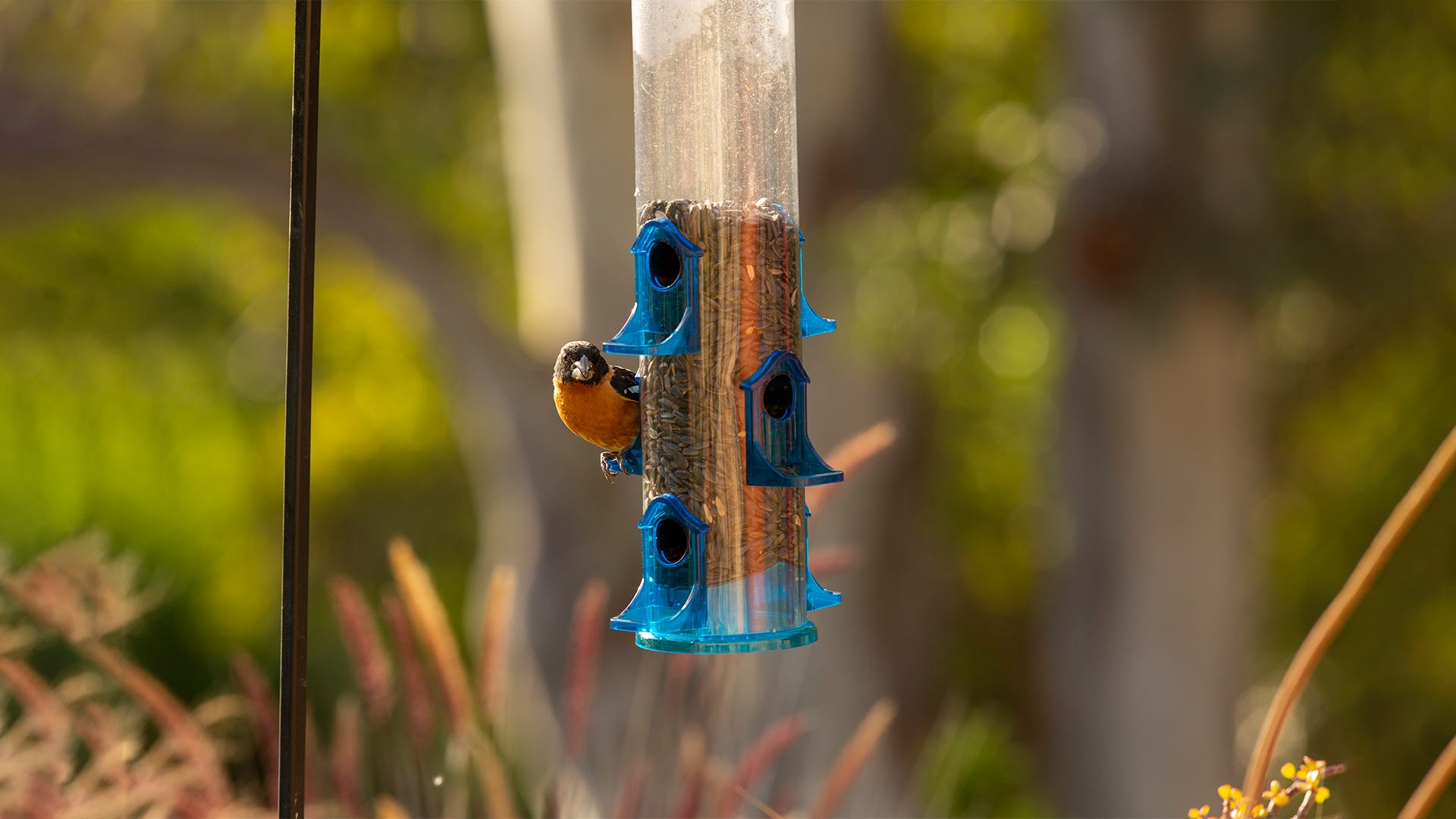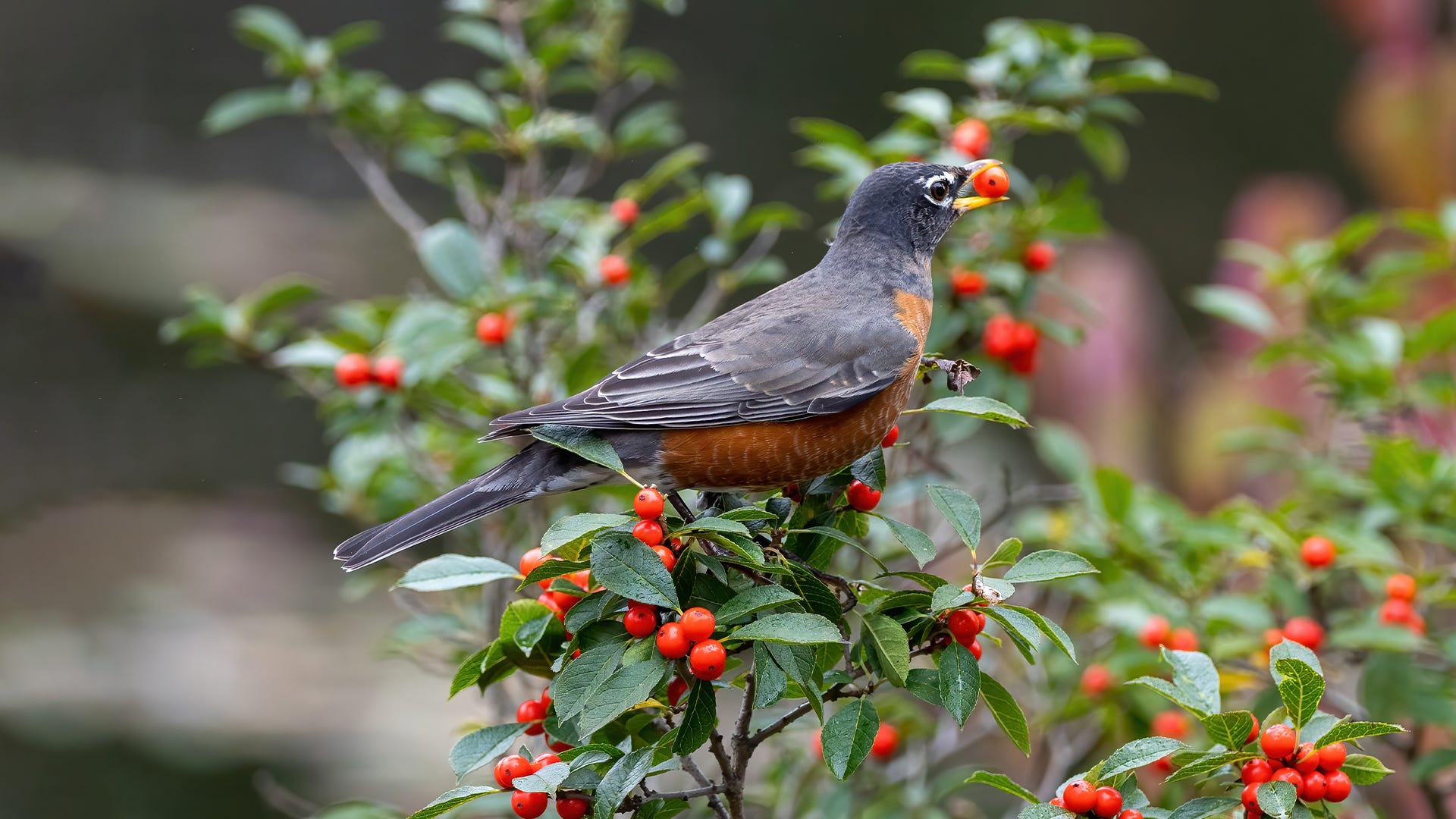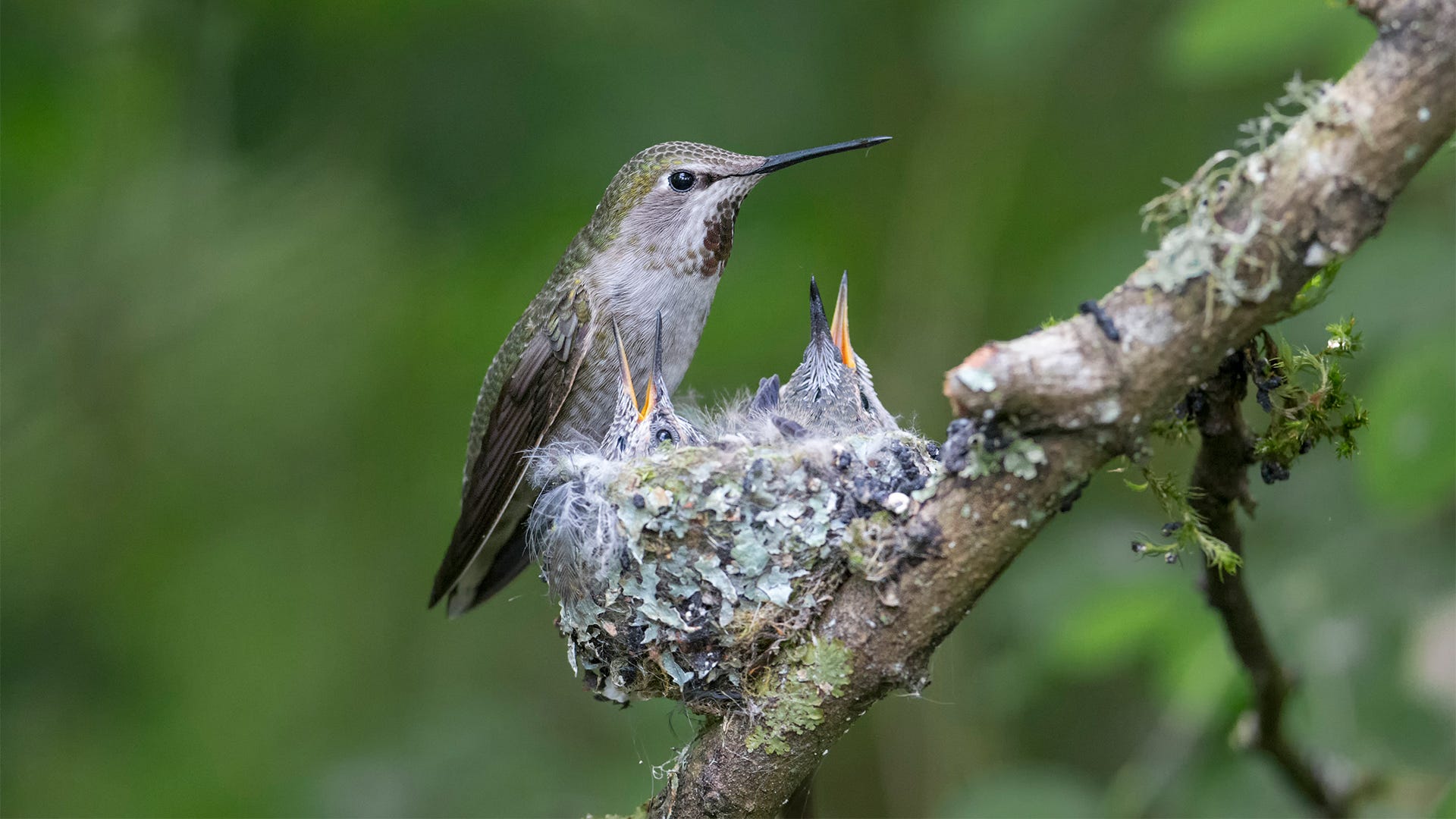
They enter this world blind, naked, and no bigger than a jellybean. But within only a few short weeks, baby hummingbirds grow into one of nature’s most fascinating and beloved birds. Here are seven of the most frequently asked questions about baby hummingbirds:
1. When is mating season for hummingbirds?
Exactly when hummingbirds breed varies with the climate in their territory.
For hummingbirds like the ruby-throated hummingbird, the males will return from their winter migration lands in Mexico and Central America in mid-March. Approximately two weeks later, the females will arrive. The males use the intervening time to claim and defend a territory suitable for building a nest.
Once the females arrive, the breeding season begins, and it can extend into July. Hummingbirds are not monogamous so, the males will mate with several females each season.
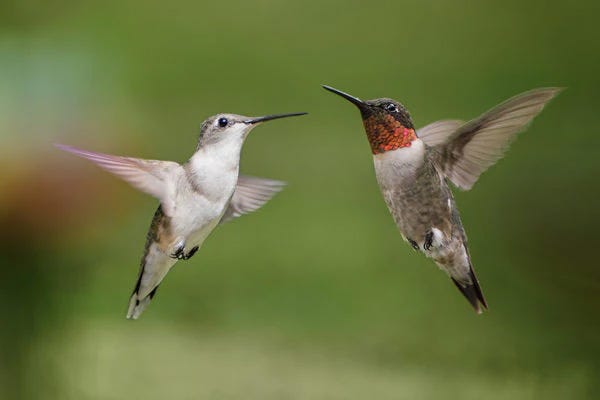
2. How many babies will a hummingbird have?
Depending on the species, their habitat, and the weather, female hummingbirds will have between one and three broods each year. Each brood will typically have two eggs, giving rise to two baby hummingbirds called chicks.
The mother usually lays her eggs a day apart, but they will hatch on the same day. Mom can control the timing because she won’t fully incubate the eggs until she lays both.
If you’re lucky enough to have a hummingbird build her nest where you can see it, you may catch a glimpse of her laying her eggs. She’ll sit in the nest, shake, and then wiggle every few seconds until her egg is safely in its nest.
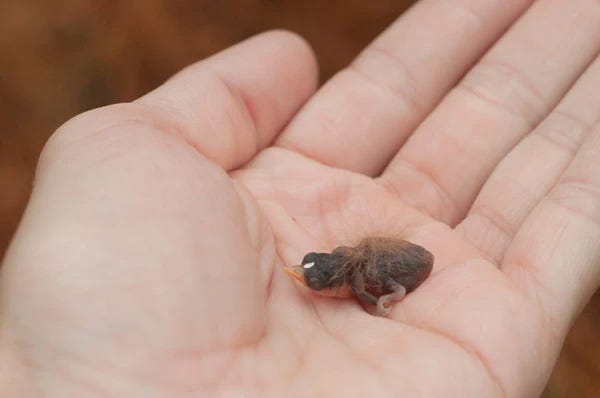
3. How long does it take a hummingbird to hatch?
Once the female lays both eggs, it’ll take between 15 and 18 days for them to hatch. If the weather is cold, it may take a few more days before the chicks are born.
The mother hummingbird will need to keep the eggs at a constant 96 degrees so, during incubation, she’ll only leave the nest for a few minutes every hour to grab a meal.
The male doesn’t help to build a nest, incubate the eggs, or feed the chicks. Once breeding has taken place, the female keeps the male at a distance. It’s likely she views him as a threat because his brightly colored feathers could attract predators—of which there are many.
4. How small is a baby hummingbird?
The short answer? Really small. Hummingbirds are the tiniest birds in the world.
Their eggs are only about the size of a coffee bean, while the nest of a ruby-throated hummingbird is about the size of half a walnut shell.
While the size and weight of a baby hummingbird will vary with the species, chicks are about one inch long, and weigh about .62 grams when born. Think of a jellybean that weighs about one-third the weight of a U.S. dime, and you’ll have a pretty good idea of just how itsy-bitsy these little birds are.
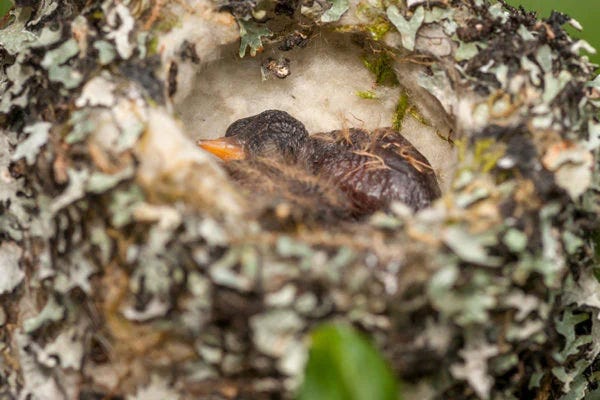
5. What does a baby hummingbird look like?
It’s understandable why many people don’t know what a baby hummingbird looks like. Their nests are so small and so well camouflaged that it’s difficult to find them. You might have one among your flowers or bushes and never know it.
What a baby bird looks like and how independent they are when born depends upon whether their species in precocial or altricial.
Precocial birds, like chickens, ducks, and owls, are born with feathers and can keep themselves warm enough not to need constant brooding. These birds are born able to see and are usually able to feed themselves within a few days after hatching. And while ducklings can swim almost immediately, precocial birds do need time to learn to fly.
Hummingbirds, like most songbirds, are altricial.
Altricial birds are born naked without any downy feathers, although hummingbird chicks do have a few yellow strands that run down their backs. It’s only after about 10 days that they’ll grow pin-like feathers that look a bit like hedgehog or porcupine spines.
Baby hummingbirds have dark skin, are blind for about nine days until their eyes open, and are unable to regulate their body temperature or feed themselves. They’re also born with short beaks that look nothing like the long, pointed beaks of their parents.
Talk about feeling helpless…
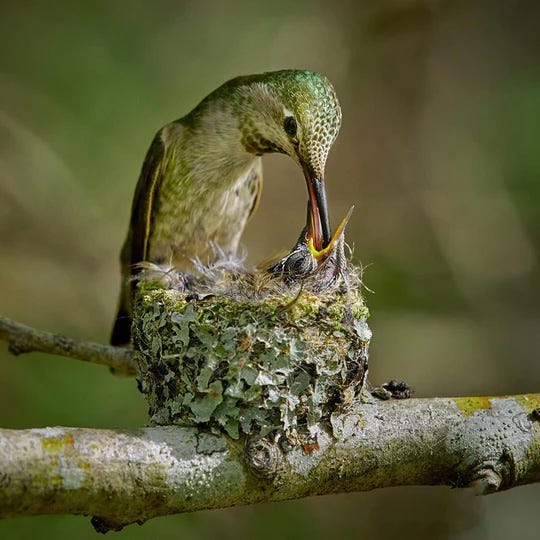
6. What do baby hummingbirds eat?
A mother hummingbird will leave the nest to drink nectar and eat soft-bodied bugs including mosquitoes, gnats, spiders, caterpillars, aphids, insect eggs, fruit flies, and small bees.
Hummingbirds, and especially growing babies, need protein in their diets if they are to remain healthy. Bugs provide that protein. That they eat mosquitoes, gnats, and aphids is a great reason to try to attract hummingbirds to your backyard.
When the mother returns to the nest, her little ones feel the wind from her wings and instinctively lift their heads and open their mouths. Mom then inserts her beak into their mouths and regurgitates the partially digested bugs and nectar.
Not exactly breakfast at Tiffany’s…
If you watch carefully and at a respectful distance, you might see the mother’s throat swell as she pumps the food out of her beak in an up and down motion.
Chicks need to eat every 20 minutes and the energy it takes to keep herself and her babies fed can take its toll. It’s why hanging a hummingbird feeder and growing plants that attract hummingbirds can mean healthier birds.
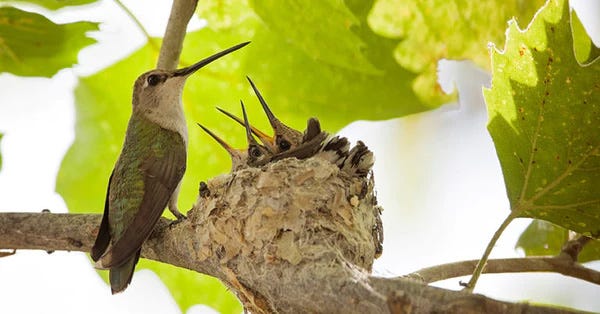
7. How long until a baby hummingbird can fly?
Hummingbirds grow up fast. At about three weeks old, they have all their feathers and while their tail feathers are still short, they can fly. It’s at about this time when they leave the nest and become fledglings.
It’s not unusual to find a fledgling hummingbird on the ground. If you find one, don’t assume it’s injured or abandoned. The mother hummingbird continues to care for her young for about another week after they have left the nest. It’s during this time when she teaches them how to catch insects on the fly and where to find nectar.
In only a single month, hummingbirds are fully mature, independent adults. They’ll have their own babies when they become one year old.
As you anticipate the return of hummingbirds, you can watch their progress using a hummingbird migration map.
If a hummingbird chooses your garden as her home, please be respectful and keep your distance. Nesting birds are particularly vulnerable. Don’t disturb an active nest and if you want to take pictures, then please follow these guidelines provided by Audubon.






